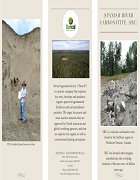Boreal Agrominerals Inc.
The Deposit

Spanish River Carbonatite is a rare magmatic, alkalic deposit characterized by:
Chemical and mineralogical complexity
- Loosely bonded nanocrystalline calcium, potassium and phosphorous are the main minerals.
- A wide array of trace elements including rare earths.
No radioactive or toxic metals
- Unlike most other carbonatite deposits, what makes SRC unique is the absence or trace amounts of deleterious materials such as heavy metals.
Disproportionate concentration of:
- Hydrolysable bases (Ca, K, Mg, Na etc.).
- Volatiles (H2O, CO2).
- Lithophile elements, (defined as a strong affinity for oxygen, having a greater free energy of oxidation).

The most naturally fertile regions on Earth exist where the above characteristics (mineralogical-biological interactions) are found in association with extremely reactive alkalic rocks. The essential primary minerals contained in these rocks are the first to be utilized in biological systems. These extremely fragile minerals do not survive geological transformations (physical, chemical or biological) and break down easily to supply the ecosystem with nutrients.
Carbonatites are relatively rare
They are igneous in origin and thus primary in nature. Carbonatites are only found at the weakened margins of colliding or separating continental plates. The magma originates from extreme depth. The Spanish River Carbonatite is located in the Precambrian Shield along an ancient rift valley. Many geologists believe the major faulting, which allowed access to deep-seated magma formed the Spanish River Carbonatite Complex and the Sudbury nickel basin were the result of a meteor impact.
Source: https://borealagrominerals.ca/products/index.html
